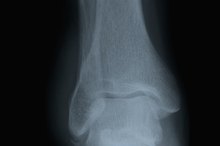Can a Broken Big Toe Later Cause Pain in the Leg?
Broken toes are surprisingly common injuries that can take between four and six weeks to heal. Depending on the severity of your break, the medial plantar nerve in your big toe may have been injured, resulting in pain or numbness in your ankle and leg. Since the nerve typically heals alongside the bone, most cases of leg or ankle pain subside after the big toe is fully healed.
Definition
Big toe fractures are among the most problematic of toe injuries, and may require a cast or surgery to keep it immobilized while healing, according to MayoClinic.com 1. Although simple fractures usually heal without incident, severe cases can increase your risk of developing a deformity or infection. If a big toe fracture does not heal properly, it can become vulnerable to osteoarthritis in the future. Although the nerve in the big toe is generally protected once the toe heals, improper healing may cause lingering pain symptoms.
- Big toe fractures are among the most problematic of toe injuries, and may require a cast or surgery to keep it immobilized while healing, according to MayoClinic.com 1.
- If a big toe fracture does not heal properly, it can become vulnerable to osteoarthritis in the future.
Broken Toe and Leg Pain
How to Put on a Knee Brace Properly
Learn More
The medial plantar nerve is the primary source of feeling and sensation to the big toe. According to the Sports MD website, it branches of the larger posterior tibial nerve located above and behind the ankle. From here, the nerve moves up your leg and to your spine along with the sciatic and other nerves. Due to the complexity of the nervous system, it is possible that an improperly healed medial plantar nerve can cause sensations of numbness, tingling or slight pain in the leg. This is only common in special cases, however, and your leg pain should be checked by a doctor for an accurate diagnosis.
- The medial plantar nerve is the primary source of feeling and sensation to the big toe.
- According to the Sports MD website, it branches of the larger posterior tibial nerve located above and behind the ankle.
Implications
Elevation and ice are the most common home treatments for reducing the swelling and pain of a toe fracture. Your doctor may recommend immobilization techniques such as buddy taping, casting or a stiff-bottomed shoe to help support your big toe as it knits back together. If the broken fragments don’t fit snugly together, your doctor may be required to manipulate the pieces back into their proper positions using a process called reduction. Most doctors will request an x-ray for patients suffering from serious big toe injuries, which will help identify the extent of nerve and bone damage caused by the fracture.
- Elevation and ice are the most common home treatments for reducing the swelling and pain of a toe fracture.
- Your doctor may recommend immobilization techniques such as buddy taping, casting or a stiff-bottomed shoe to help support your big toe as it knits back together.
Safety Concerns
What Are the Treatments for Thigh Splints?
Learn More
Talk to your doctor if you still experience pain or other symptoms in your toe, ankle or leg. Most likely, your doctor will schedule a follow-up x-ray to determine if your symptoms are stemming from improper healing. In serious cases, your big toe may require surgical procedures that use pins, plates or screws to maintain proper bone alignment during healing.
- Talk to your doctor if you still experience pain or other symptoms in your toe, ankle or leg.
- In serious cases, your big toe may require surgical procedures that use pins, plates or screws to maintain proper bone alignment during healing.
Related Articles
References
- MayoClinic.com: Broken Toe
- eMedicineHealth: Broken Toe
- Sports MD: What Is Jogger's Foot (Medial Plantar Neuropraxia)?
- Industrial Health: Medial Plantar Nerve Conduction Velocities Among Patients With Vibration Syndrome Due To Rock-Drill Work
- Goost H, Wimmer MD, Barg A, Kabir K, Valderrabano V, Burger C. Fractures of the ankle joint: investigation and treatment options. Dtsch Arztebl Int. 2014;111(21):377-88. doi:10.3238/arztebl.2014.0377
- Shur V, Georgiev K. Stabilization technique for comminuted medial malleolus fractures. Techniques Orthop. 2015 Dec;30(4):259-61. doi:10.1097/BTO.0000000000000095
- Lu J, Maruo Holledge M. Medial malleolus fracture of the ankle combined with rupture of the Achilles tendon. J Surg Case Rep. 2016;2016(4). doi:10.1093/jscr/rjw062
- Lampridis V, Gougoulias N, Sakellariou A. Stability in ankle fractures: diagnosis and treatment. EFORT Open Rev. 2018;3(5):294-303. doi:10.1302/2058-5241.3.170057
- Hidden KA, Jamieson MD, Groth AT. Utilizing the locking peg hook plate for a comminuted fracture of the medial malleolus. J Orthop Trauma. 2019;2019;e1-4. doi: 10.1097/BOT.0000000000001591
Writer Bio
Based in the Appalachian Mountains, Brian Connolly is a certified nutritionist and has been writing professionally since 2000. He is a licensed yoga and martial arts instructor whose work regularly appears in “Metabolism,” “Verve” and publications throughout the East Coast. Connolly holds advanced degrees from the University of North Carolina, Asheville and the University of Virginia.








